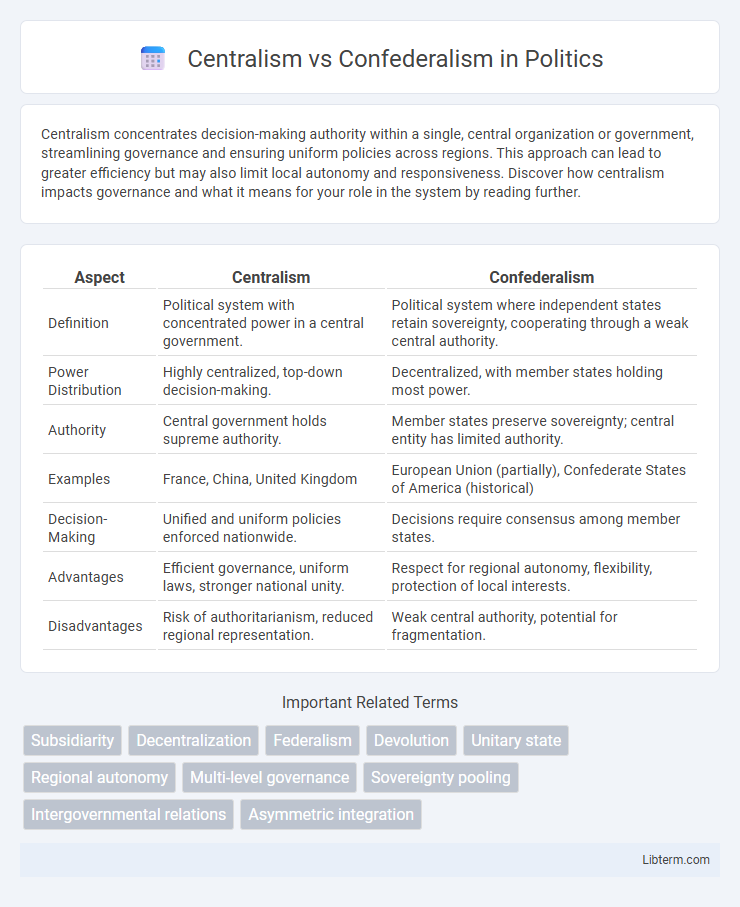Centralism concentrates decision-making authority within a single, central organization or government, streamlining governance and ensuring uniform policies across regions. This approach can lead to greater efficiency but may also limit local autonomy and responsiveness. Discover how centralism impacts governance and what it means for your role in the system by reading further.
Table of Comparison
| Aspect | Centralism | Confederalism |
|---|---|---|
| Definition | Political system with concentrated power in a central government. | Political system where independent states retain sovereignty, cooperating through a weak central authority. |
| Power Distribution | Highly centralized, top-down decision-making. | Decentralized, with member states holding most power. |
| Authority | Central government holds supreme authority. | Member states preserve sovereignty; central entity has limited authority. |
| Examples | France, China, United Kingdom | European Union (partially), Confederate States of America (historical) |
| Decision-Making | Unified and uniform policies enforced nationwide. | Decisions require consensus among member states. |
| Advantages | Efficient governance, uniform laws, stronger national unity. | Respect for regional autonomy, flexibility, protection of local interests. |
| Disadvantages | Risk of authoritarianism, reduced regional representation. | Weak central authority, potential for fragmentation. |
Understanding Centralism: A Brief Overview
Centralism is a governance system where decision-making authority is concentrated in a central government, ensuring uniform policies and laws across all regions. This structure facilitates streamlined administration and stronger national unity but may limit regional autonomy and local responsiveness. Countries like France and China exemplify centralist models, prioritizing centralized control to maintain political stability and economic coordination.
Defining Confederalism: Key Characteristics
Confederalism is a political system where multiple sovereign states or regions retain significant independence and delegate limited powers to a central authority, mainly for common defense or external affairs. Key characteristics include decentralized governance, strong regional autonomy, and decision-making primarily at the local level rather than by a dominant central government. This system contrasts with centralism by emphasizing cooperation among equal entities rather than hierarchical authority.
Historical Roots of Centralism and Confederalism
Centralism finds its historical roots in the consolidation of power witnessed in early modern nation-states like France under Louis XIV, where a strong central authority was established to unify fragmented territories and enforce uniform policies. Confederalism emerged from the decentralized political arrangements of entities such as the Articles of Confederation in the United States and the Swiss Confederacy, emphasizing the sovereignty of individual states within a loose alliance. The contrasting historical development of these systems reflects differing approaches to governance, balancing authority between a central government and constituent political units.
Political Power Distribution: Centralism vs Confederalism
Centralism concentrates political power within a single, central authority, enabling uniform policy enforcement and streamlined decision-making across the entire state. Confederalism disperses power among constituent entities, granting them substantial autonomy to govern independently while the central body handles limited, collective matters. This fundamental difference shapes how authority is exercised, with centralism favoring centralized control and confederalism emphasizing regional sovereignty.
Economic Implications: Centralized vs Confederal Structures
Centralism fosters uniform economic policies, enabling streamlined taxation and resource allocation across the entire nation, which often leads to enhanced fiscal stability and large-scale infrastructure development. Confederalism, by distributing economic autonomy to member states, allows tailored economic policies that reflect local needs but can result in fiscal disparities and coordination challenges. Centralized structures typically attract consistent foreign investment due to policy predictability, whereas confederal models face complexities in market integration and regulatory harmonization.
Governance Efficiency: Advantages and Drawbacks
Centralism enhances governance efficiency by streamlining decision-making through a unified authority, reducing bureaucratic delays and ensuring consistent policy implementation across regions. However, it risks overburdening central institutions and may lead to reduced local responsiveness or adaptability. Confederalism promotes localized governance that can tailor policies to regional needs, but this decentralization often results in coordination challenges, slower decision processes, and potential inconsistencies in law enforcement.
Case Studies: Examples of Centralist and Confederal Systems
Federal Germany exemplifies centralism with a strong federal government coordinating policies among its 16 Lander, ensuring uniformity in defense and economic affairs. In contrast, the Swiss Confederation showcases confederalism, where its 26 cantons maintain significant autonomy with decentralized political powers and decision-making. The European Union operates as a hybrid system, blending confederalist principles in areas like foreign policy with centralist elements in regulations and trade.
Social and Cultural Impacts of Both Models
Centralism often leads to cultural homogenization by promoting a unified national identity, which can marginalize regional languages and traditions, while confederalism allows for greater cultural diversity by granting autonomous regions the power to preserve and celebrate their unique social customs. Social cohesion under centralism might benefit from standardized policies and shared national values, but it risks alienating minority groups. Confederalism fosters localized social networks and cultural expression but may struggle with national integration and equal resource distribution across regions.
Modern Trends: Shifts Between Centralism and Confederalism
Modern trends reveal fluctuating preferences between centralism and confederalism, reflecting political, economic, and social shifts in governance. Countries like Spain and Belgium exhibit movements toward confederal arrangements to accommodate regional identities, while others revert to centralism to maintain national unity and streamline decision-making. Technological advancements and globalization pressure states to balance centralized authority with decentralized autonomy, driving dynamic governance models that integrate both principles.
Which Model Fits Best? Factors Influencing Adoption
The choice between centralism and confederalism depends on factors such as the degree of political unity desired, the cultural and ethnic diversity of the population, and the need for efficient decision-making. Centralism suits states requiring strong, unified governance and standardized policies, while confederalism fits regions valuing regional autonomy and decentralized power. Economic integration levels, historical context, and security concerns also significantly influence the adoption of either model.
Centralism Infographic

 libterm.com
libterm.com